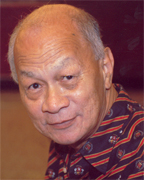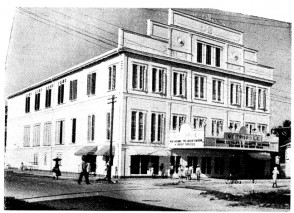On Tuesday, Septem-ber 7, 2004, my favourite cinema, the Metropole, in Georgetown was destroyed by fire. This is the fourth cinema to be lost in this fashion: the Gaiety by the Brickdam Cathedral in 1926; the Doren (refurbished Rialto) in the late sixties(?) and Ho-A-Yun’s Gaiety in New Amsterdam off the Ferry Stelling.
I hasten to record my memories of the Metropole, purely because of the social impact the cinema and movies had on the entertainment and the maturation of every Guyanese at home or abroad yesteryear.
The Metropole would be in the same class as the Empire on Middle St – a similar design, and both built in the mid-thirties before the Astor, which opened in 1940 with Golden Boy. Other competing cinemas in the thirties included the London (which became Plaza in ’51); the Olympic, Lombard St, replaced by GNEC; the Rialto, Vlissengen Road (later the Doren and Liberty); and the Capitol, Albouystown, which later became Rio.

New kids to the block then were the Globe (opening with David & Bathsheba) opposite the Astor (1952?) and Strand Deluxe, 1957, opening with Sayonara.
In the thirties, the London (later Plaza) must have been our parents and grandparents’ favourite cinema.
My earliest recollection of movies seen at the Metropole was in 1944, when at age 7 I saw Tarzan and his Mate and Robert Taylor as Billy the Kid. Three Tyrone Power adventures – Blood and Sand, Crash Dive and Black Swan – came during the war when I had my own seat in the Pit with ‘God’ on it (penknife carved), and matchstick scarred from trying to keep away the voracious bugs. Some idiot added a ‘y’ later – don’t you hate vandals who go around despoiling public property?
At a sell-out double in 1945 at the Metropole, first there was a Shirley Temple, while the second feature was Prisoner of Shark Island when midway, the acetate film can be seen to burn on the screen – burst – and some idiot from House shouted “Fire.” Pandemonium broke out, a riot ensued and many of the Pit benches, including ‘mine’ were pulled through the Pit exit onto the Wellington Street pavement. A few bottles were thrown into the screen, and order was only restored when management agreed to show the end of the movie. Cecil ‘Pluto’ Martindale said a few years ago he also witnessed that fiasco.
Incidentally my mother insisted I view Gone with the Wind when it was re-released at the Metropole in 1945.
For the fanatical local movie fans, all cinemas proximate to your ‘casa’ were favourites. The prices for the four-tiered class segregation – Box/Balcony; House; Pit – were the same at each theatre, and all cinemas took turns as favourites from week-to-week, depending on ‘current releases.
Facilities and comfort didn’t matter before our national awakening at Independence, 1966. The Olympic had no roof initially, and was often referred to as the ‘fowl-s—t theatre,’ with its own loyal clientele.

And when Plaza opened in 1951, the Pit was given individual chairs, on the same tier level as House.
The Metropole had a huge four-story glass panelled front with a marquee awning over the front pavement entrance. There were two large pane-glass panels at either side where poster and lobby picture cards would attract the attention of anxious patrons.
Within the main entrance a ticket box beckoned, with two wide staircases on either side, ascending to the second level House. The ticket collectors would direct you to two vertical winding staircases if your ticket was Balcony. Box patrons walked through the balcony to a leathered upholstered box up front, with a commanding overhead view of the usually noisy Pit, and the screen on a huge curtained stage. Late-comers in the Pit customarily shouted “Upstairs start over!”
The Pit’s narrow box-like ticket cubicle at the back of the cinema over a wide concrete alley, was a black hole of Calcutta, with a slot just large enough for your ‘jills.’ The Pit entrance was to the west. Further back there was a huge outside staircase exit for House and Balcony/Box, with the bicycle room immediately below at floor level under the House. An ice-cream parlour was located at the north-eastern end, with an entrance from the Wellington Street pavement.
In 1954, Metropole released the scintillating exploits of the Harlem Globe Trotters in Go-Man-Go. A basketball hoop and backboard were immediately installed in the Taitt’s yard in Murray Street (now Cara Lodge) and the Ravens-Panthers-Clowns rivalry soon started. Hard courts were installed at the Parade Ground and Cosmos, and basketball became a national sport by 1957.
In the fifties and early sixties Hollywood tried to counter the competition of the small-screen television with CinemaScope, Cinerama and 3D; and lavish epic spectacles such as The Ten Commandments, Ben Hur, Dr Zhivago, Bridge on the River Kwai and Around the World in Eighty Days. The local cinemas installed the wide screens and by 1955, Metropole refurbished and re-opened with The Benny Goodman Story; Creature of the Black Lagoon, It came from Outer Space and Destination Moon were also released there.
Under the new ownership of cinema magnate Robert Sookraj the Metropole became a Xanadu among his expand-ing chain that included the Empire, Hollywood and Doren, and the 30-year Golden Age of cinemas in Guyana 1952-1982 started.
Metropole was the venue of that tumultuous meeting of the political peas in the same pod – January 1955 when Cheddi and Odo split and the life of every Guyanese changed forever.
The Metropole was the standard-bearer for the best movie experience locally in terms of the comfortable, well-maintained facilities and up-to date equipment. More important, the doubles movie fare offered was the best in the world.
Robert Sookraj’s approach to doubles movie billing was similar to that of an entrepreneurial used-car salesman. By the mid-fifties, the merger of MGM and 20th Century Fox for distribution locally made available to the Metropole a huge stockpile of Hollywood’s best films. First releases at the other cinemas were doubled at the Metropole two months later. The local big-eye Guyanese could afford to wait, and became spoilt.
For those who can remember, the popular Saturday Night Fever ran three months at the Astor on release in 1978, but had to be doubled with a different B picture each week.
Sookraj’s theme programming revolutionised billings where a contrast comedy-musical plus adventure was the popular fare. Can you imagine Butterfield 8 and Cat on a Hot Tin Roof (both starring Liz Taylor) at the Metropole after individual first releases of six days elsewhere? Lana Turner’s Imitation of Life plus Madame X had the ladies’ handkerchiefs wet, with sniffles and tears, plus action flicks for the macho males.
Longest Day and Guadacanal Diary – Guyanese doubles – were more ‘belly full’ than the Trinis’ doubles!
The length of a doubles programme was not a hindrance, but a cultural phenomenon. The Nun’s Story (Audrey Hepburn), 151 minutes, doubled with Young Philadelphians (Paul Newman), 136 minutes – a 5 hour programme – meant considerable overlap with 3 shows at 12.30, 4.45 and 8.30 pm. It was a ‘zoo,’ with the 4pm workers hustling waiting in the lobby, and the scalpers Barney Johnson and Bruk-Up creating sell-out scares. From womb to tomb, even at the cinema, life was a hustle.
The night show was a titanic rush. Starting after 10 pm, you entered the cinema as the afternoon patrons exited through the side exits. It was dark like hell as you groped to find a seat, with upcoming trailers on the screen. The experience was like a Rupununi cattle rustle – nuff mash foot, beg pardon and ‘locust.’
The night shows ended foreday morning. You bought a Graphic exiting the cinema, stopped for a cook-up at Hunte or Pemya by the roadside, and chased with a coconut water. And next day at work, you gaffed the previous night’s escapade – night-owl civil servants dozing off on the job!
In February 1960 movie doubles reached a Guinness ‘high’; Metropole released a new double each day for 29 days (season tickets were available) and the revenue collectors were in a tizzy. I had the privilege of selecting the doubles and producing my first whole-page newspaper advertising supplement, all for free admission for the leap year month.
Metropole exhibited movies for the benefit of the movie fans with the skill of Madison Avenue. In 1968, shortly after Independence, the cinema released with a public appearance by E R Braithwaite, the exploits of a Guyanese son of the soil as a teacher in England – To Sir With Love.
My favourite ‘nylon’ re the Metropole, is meeting a former Metropole Manager in Port Kaituma shortly after the Jonestown tragedy of 1978. With head hanging down like Tom Dooley, he explained that in the late fifties advance ticket sales were sold out for the upcoming Platters show, when he received the following cable, from the US Agents: “Regret Platters cannot visit Guyana – All flights from Miami snowbound.”
He fled G’town that night, and now nineteen years in the bush, was awaiting the statute of limitations the next year.
When Strand released in 1973 the story of Papillon’s adventure in French Guiana, Metropole pre-empted with Jim Brown in Escape from Devil’s Island. Strand also released Towering Inferno in 1975 – the night Guyana turned back the clock – but Metropole capitalised a few weeks earlier with Blazing Towers, a copycat high rise catastrophe.
As a movie fanatic, I even kept abreast of world affairs at the Metropole. Princess Elizabeth’s wedding in1947 was broadcast live by radio there at 7am, followed by a chapter-play serial – Victor Jory in the Shadow at 9am.
Metropole could safely be deemed the fountain of the Guyana movie experience. Indeed, I venture to proclaim it was the centre of Georgetown’s entertainment for many years. Within three blocks we could dine at Bamboo Gardens, National, Rendezvous, Brown Betty and Coalpot; take out chicken from Oasis, Farm Fresh or Sip and Chat; and disco at Dog and Bone or Guiding Light.
Television did not come to Guyana, for better or worse, until the mid-eighties. Replacing the stereogram or hi-fi stereo, status symbols of the well-off up to the seventies, was a top-loaded VCR and TV monitor, imported through contacts and lines, and sold locally for $15,000. Friends or family sent VCR/Betamax copies of movies, together with the list of hard-to-get items locally, and a new industry started.
The Guyana cinema experience is now like the Dodo – a sad story!








